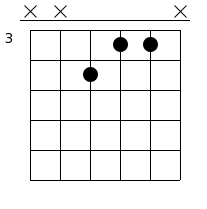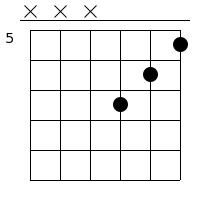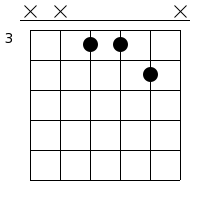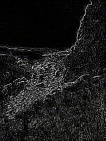Updated February 25, 2024
Click on the buttons to tune the six strings of your guitar in major thirds (M3)






(standard tuning at bottom of page)
All M3 diatonic chords at a glance!
Major scale (here D major) |
|---|
 |
| Simply move your hand along or across the neck for ALL other major scales! |
Minor scale (here B minor) |
|---|
 |
| Simply move your hand along or across the neck for ALL other minor scales! |
Contents
The guitar is more flexible than the keyboard
Uniformity at your fingertips
Summary of the benefits of a regular and periodic tuning
Barred chords in standard tuning: firing on all cylinders...
...and the straitjacket is tight
The barred chords in M3: minimalist but stunning
Using TuxGuitar, recycle your tablatures
Chord tables
References, comments
Major thirds: a new tuning that changes everything
The guitar is more flexible than the keyboard
Though not really a fixed noted instrument, the guitar is just as well an equal temperament instrument: the distances between frets of practically all contemporary guitars enforce the frequency ratios characteristic of the equal temperament. Nonetheless, traditional guitar tuning presents us with a major irregularity : the second string is 2 tones above the third string (major third interval), though all other strings are tuned 2½ tones above the next lower string (fourth interval). The guitarist however has a decisive advantage over the keyboard or electronic keyboard player: of course he can tune his guitar as desired at any moment, but above all he is not blocked by material layout which cannot be worked around, since the guitar's fretboard is basically uniform.
Uniformity at your fingertips
More than once had I wondered if it would be practicable to avoid this discontinuity between the 3rd and 2nd strings. The first reaction is an attempt to tune all strings in fourths. So the interval between the 3rd and 2nd strings is increased by a semi-tone, in order to make it equal to the others, namely a fourth. Big fingering issues then appear for simple chords already. That is indeed the way bass guitars are commonly tuned, but this instrument is not usually used to play chords. So I adopted the other solution, namely applying to all strings the interval between the 2nd and the 3rd. In other words, I tuned my guitar in major thirds (M3 for short).
Since that day, my relation with the guitar has changed completely. Before, I did my best to reproduce and memorize compositions, with no hope to get close in any fashion to the great interprets. Today, I am most often improvising, and when I am inspired by an existing piece, I do not have to work hard to acquire automatisms, because, thanks to the instrument's uniformity, it does not take long until you can play naturally (not unlike singing). Actually we could repeat the words of our friend Johann Sebastian « So spielt das Instrument von selber » ! [3]
Summary of the benefits of a regular and periodic tuning
- Triad positions (3 notes chords), major and minor (fundamental and both inversions) are dirty simple, and transposable not only along the fretboard (as with barred chords in standard tuning) but, great novelty, across the neck!
- the augmented (resp. diminished) chord positions, that is series of major (resp. /minor) thirds, are quite as easy and transposable;
- adding a sixth, a seventh, a ninth or eleventh is done without awkward finger stretching on the perfect major or minor fundamental chord and on both inversions;
- in all cases, adding the octave is straightforward: it is the same fret, 3 strings higher. This is an crucial point that, together with the much greater easiness of the fingerings, makes up most of the superiority of major thirds over the other uniform challenger, the all fourths tuning.
- The sole drawback with M3 (not counting the change of habits) is the shortening by two wholetones of the overall pitch span of the instrument. Demanding players who wish to remain able to play the most acrobatic soli could consider moving to a 7 strings guitar. Such instruments are becoming affordable, but it is worth noting that the symetry between the 3 bass and the 3 trebles strings is then lost. A satisfactory solution for such cases mitht be a guitar with cutaway, but this is by all means a personal choice.
Beyond easiness of triads, enriched chords and transposing, by tuning your guitar in major thirds you come to master the chord inversions in a breeze. This is undoubtedly an essential aspect of music. However, it is completelely neglected by the usual practice of accompaniment guitar, where it is commonly accepted to repeat as many chord notes as possible, trying to keep the specified bass note, but with minimal attention to the relative strength and octaves of the fundamental, third, fifth, etc. This is particularly blatant with barred chords in standard tuning.
Barred chords in standard tuning: firing on all cylinders...
Let's see this last aspect in more details:
- in position I (i.e. F major when the first fret is barred), the fundamental is used three times and the fifth is repeated below the third. The third however is not repeated, which complies with the theory
- in position III (i.e. B flat major when the first fret is barred), it is getting more questionable : the fundamental is doubled, but the fifth is tripled! The third is still left unrepeated
- in position II (i.e. D flat major when the first fret is barred, not easy to play) the fundamental is doubled at the lower octave, but this time (sweet revenge!) the third is now tripled!
| Analysis of bar chord comosition in standard E/A/D/G/B/E tuning | ||
|---|---|---|
| F major I | Bb major III | Db II |
 |
 |
 |
So it seems that upper or lower octaves are added in a complete anarchy. Of course a louder, maybe apparently richer sound can be interesting for accompaniment, but we lose control over what is played. In particular, this practice seems to deny any significance to inversions. However, if we play the perfect triad (fundamental state) in arpeggio, followed by the sixth chord (first inversion) and then the fourth and sixth triad (second inversion), it is not at all the same thing! (see [7])
...and the straitjacket is tight
With the traditional tuning, we have:
- the fundamental triad in position I
- the first inversion in position II
- the second inversion in position III
In all three cases, the clean triad lays on strings 2, 3 and 4. By playing those strings only, we are then able to transpose a clean chord along the fretboard, but not across the fretboard, which strongly limits the possibilities. The position of the added notes (minor or major 7th, 6th, etc.) changes depending of the type (I, II or III) of the barred chord and is at least problematic, for there is no more free finger to play them and enrich the triad. The same remark holds for augmented chords. Diminished chords can be forgotten altogether since they are practically unplayable in this way.
The bars in M3: minimalist but stunning
With the major third tuning, playing minor and augmented barred chords is a child’s play. In the latter case, you get three distinct minor triads on the same hand position (e.g. Am, Fm and C#m with open strings or Gm, Bm and Ebm with the index in 2nd fret). All the notes being doubled at the octave, these very rich chords allow interesting effects to be obtained effortlessly.
Unlike standard tuning where the open strings played all together are dissonant, the open strings or a barred with the index finger alone at any position gives in M3 an augmented chord, which can advantageously replace the dominant 7th chord in some cases.
Using TuxGuitar, recycle your tablatures
If you get caught with this new tuning but just can’t do without tablatures, rejoice: adapting tablatures to a new guitar tuning can be done easily. Just install the great free software called TuxGuitar, written in java and then running on any platform (Windows, Linux and Mac). You’ll be able to adapt your tablatures even with a 7 strings guitar!
Chord tables
Here are the main fingering examples in major thirds tuning. Except at the nut where some strings will be played open, the fingerings remain exactly the same when transposing along the fretboard. The same is true when transposing accross the fretboard, with the obvious exception of the fretboard’s sides. Consequently, for enriched chords in particular, you will have to find alternatives positions for additional notes (sixth, seventh, ninth, etc.) when the normal position would be out of the fretboard.
The diagrams were composed using TuxGuitar.
| Fundamental chords in C major for E/Ab/C/E/Ab/C tuning | ||
|---|---|---|
| C major | F major | G 7 |
 |
 |
 |
| Secondary chords in C major for E/Ab/C/E/Ab/C tuning | |||
|---|---|---|---|
| D minor | E minor | A minor | |
 |
 |
 |
|
| B diminished | |||
 |
|||
| Enriched C major chords for E/Ab/C/E/Ab/C tuning | ||
|---|---|---|
| C major 6 | C major 9 | C major M7 |
 |
 |
 |
| Suspended chords for E/Ab/C/E/Ab/C tuning | |||
|---|---|---|---|
| C sus2 | C sus4 | ||
 |
 |
||
| Inversions of C major chord for E/Ab/C/E/Ab/C tuning | ||
|---|---|---|
| C major | C major 1st inv. or C maj/E | C major 2nd inv. or C maj/G |
 |
 |
 |
| Fundamental chords in C minor for E/Ab/C/E/Ab/C tuning | ||
|---|---|---|
| C minor | F minor | G 7 |
 |
 |
 |
| Inversions of C minor chord for E/Ab/C/E/Ab/C tuning | ||
|---|---|---|
| C minor | C minor 1st inv. or C min/E | C minor 2nd inv. or C min/G |
 |
 |
 |
And so on... Thanks to the major thirds tuning, the chord structures given above remain valid in all the keys, by translating along or accross the fretboard. If you want to have more strings sounding, remember that you can always add the same fret position 3 strings higher or lower. For major thirds as well as for any other tuning, TuxGuitar can also offer you a plethora of alternative positions and fingerings, though this is generally superfluous when you are tuned in M3.
References, comments
An article dedicated to this regular and periodical way of tuning the guitar was recently published on Wikipedia [2] . Since an extensive list of references is provided there, I will just point to the most comprehensive website I know about major thirds guitar, including tips and tricks as well as significant theoretical and musical material [5].
- [2] Major thirds tuning - Wikipedia, the free encyclopedia
- [3] “ So the instrument plays by itself. ”
- [5] M3 Guitar -- Play any style of music on an electric or acoustic guitar tuned in major thirds
- [7] MAX D'OLLONE, Le langage musical, Éditions La Palatine. tome 2, p.70 (in French)
Click on the buttons to go back to standard tuning






(major thirds tuning at top of page)
